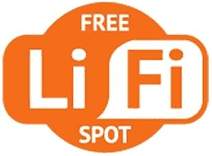Li-Fi: how a LED bulb turns into a modem
 For several years, scientists have been experimenting with new technology for transmitting data through LEDs in fluorescent lamps. Paired with a photodetector, the lamp turns into a normal modem. By analogy with Wi-Fi, this type of connection is called Li-Fi. If the LEDs flicker with high frequency in different colors, then a fairly high data transfer rate can be achieved. For example, the Germans two years ago recorded a speed of 800 Mbit / s at a distance of 1.8 meters in laboratory conditions. However, they have not yet reached the practical implementation.
For several years, scientists have been experimenting with new technology for transmitting data through LEDs in fluorescent lamps. Paired with a photodetector, the lamp turns into a normal modem. By analogy with Wi-Fi, this type of connection is called Li-Fi. If the LEDs flicker with high frequency in different colors, then a fairly high data transfer rate can be achieved. For example, the Germans two years ago recorded a speed of 800 Mbit / s at a distance of 1.8 meters in laboratory conditions. However, they have not yet reached the practical implementation. But engineers from Fudan University in Shanghai recently conducted an experiment with Li-Fi , where four personal computers accessed the Internet through one 1-watt LED bulb.
According to the authors of the study, a light bulb with a microcircuit provides a data transfer rate of up to 150 Mbps. The technology is ready to use: on November 5, they promise to bring ten sets of Li-Fi samples to the China International Industry Fair.
Although this method of transmission, by definition, works only in the line of sight, it is theoretically possible to combine all the lamps in the apartment into a mesh network through which you can transmit a signal, for example, from one room to another through a common corridor. The lamps flicker at a high frequency, this should not be noticeable to the eye. For comparison, a standard fluorescent lamp flickers with a frequency of 10 to 40 kHz. That is, it will seem to a person that the lamp shines as usual.
Engineers believe that using light as a carrier has advantages over radio waves. Firstly, the benefit in energy consumption: in radio modems, the efficiency does not exceed 5%, most of the energy goes into heat. Secondly, theoretically, light can transmit information at a much higher speed than by radio, simply due to a shorter wavelength. Thirdly, light bulbs can be used in hospitals, and in a densely populated city hotspots will not interfere with each other, like WiFi.
